It has been a feasible approach to build an antenna, in view of the potential advantages they offer. One of the recent trends in dielectric resonator antenna research is the use of compound and hybrid structures. Several considerable investigations have been already underway showing quite interesting and significant features in bandwidth, gain, and generation of circular polarization.
- CP radiation
- microstrip antenna
- dielectric-resonator antenna
- hybrid dielectric resonator antenna
- wide-band antennas
- multi-functional antennas
1. Introduction
The radiation mechanism of various types of antennas and their radiation fundamentals, focusing on the concepts of circular polarization, are comprehensively discussed in [1][2]. Circularly polarized (CP) antennas can offer a consistent or reliable system connection between the transmitter and receiver, since the polarization of the antennas is always associated. In and around the intended resonant frequency, two modes orthogonal to each other with a phase-shift of 90° are desired for circular polarization. Therefore, using receiver antennas with the same phase center and orthogonal polarizations can avoid location-induced phase variation.
2. Classification and Progress of Dielectric Antennas
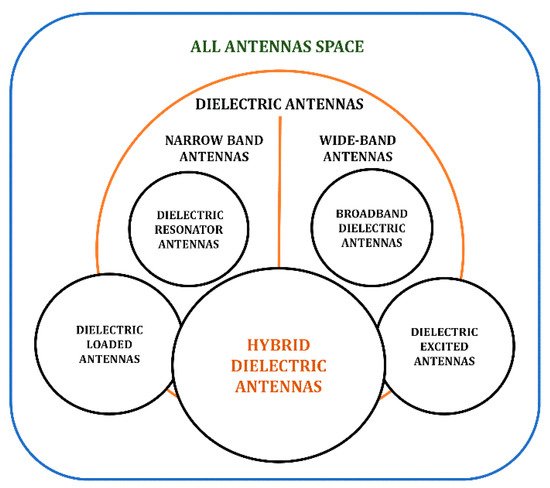
The past review studies of the dielectric resonator antennas have been summarized in Table 1 to highlight the various significant radiation and design aspects. The stored energy inside the dielectric is exceptionally high and it is difficult for external objects to detune the device [8][9][10]. DR can radiate from all surfaces, rendering high radiation efficiency and low Q-factor.
| Year | Past Review Highlights | Reference |
|---|---|---|
| 1994 |
|
[11] |
| 2005 |
|
[12] |
| 2006 |
|
[13] |
| 2010 |
|
[14] |
| 2010 |
|
[15] |
| 2012 |
|
[16] |
| 2014 |
|
[17] |
| 2015 |
|
[18] |
| 2016 |
|
[19] |
| 2017 |
|
[20] |
| 2017 |
|
[21] |
| 2019 |
|
[22] |
| 2020 |
|
[23] |
The primary radiating component of the Dielectric Loaded Antennas is a conducting element and the dielectric modifies the medium, imparting significant performance advantages [24][25][26][27][28]. Dielectric antennas can be used to excite parasitic copper antennas or vice versa. In this class of antennas, often the conductor forms the major radiating part of the antenna. There are bandwidth advantages in this dielectric–copper hybrid approach of the Dielectric Excited Antennas [29][30][31][32].
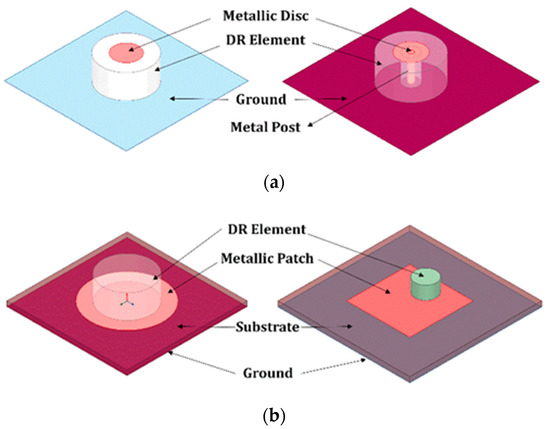
3. Circularly Polarized DR Based Hybrid Antennas
3.1. Wideband Hybrid Antennas with CP Radiation
Several CP radiation techniques and respective design methods have been implemented independently for microstrip and dielectric resonator antennas. However, CP radiation techniques for hybrid dielectric resonator antennas over a wide-bandwidth are challenging [67]. A compact dielectric-loaded aperture-coupled microstrip antenna is reported for L-band mobile satellite applications with CP radiation. Two dielectric-inserts [68] along the edges of the square patch are positioned for the required reduced frequency shift of 30% to the lower-side, and the cross-slot aperture creates the two-orthogonal modes desired for CP radiation with 2.5% of 3 dB AR bandwidth compared to traditional CP square patch. Similarly, four dielectric inserts [69] are used under the square patch positioned at the edges with a cross-slot feed to obtain the CP radiation. A considerable reduction of antenna size is possible by inserting dielectric blocks beneath the patch, while the desired bandwidth and the axial ratio are also achieved for L-band applications [70].
A modified cross-slot is concurrently acting as a radiator as well as the feeding element to the DR antenna. The resonances of modified cross-slot and DR elements are combined to form a wideband CP radiated hybrid DRA [71] with a 3 dB AR bandwidth of 24.6% (2.25–2.88 GHz) and 10 dB return-loss bandwidth of 28.6% (2.19–2.92 GHz). A hybrid structure is formed, combining a stair-shaped DR element with an open-ended slot [72] on the ground plane, which is reported for wideband CP radiation. The open-ended slot on the ground plane is responsible for a lower frequency of resonance (at 4.5 GHz) and, in turn, a wide axial-ratio bandwidth is obtained. By varying different parameters of the hybrid structure, a wide impedance bandwidth of 71.7% (3.844–8.146 GHz) and an AR band-width of 46% (4.15–6.63 GHz) is obtained. A simple feed network along with two vertical strip-lines are arranged [73] as shown in Figure 3 to produce orthogonal fields of hybrid HEx11$ and HEy11$ modes (presented in Figure 4) in the cylindrical DR element for wide CP radiation with AR bandwidth of 24.6% (2750–3520 MHz). The length of the vertical strip-lines along the cylindrical surface of the DRA controls the LHCP and RHCP radiation. A circularly polarized multiple inputs multiple output (MIMO) hybrid antenna [74] is formed by a parasitic patch, and the conformal strips along the sidewalls of two identical rectangular DR elements are shown in Figure 5.
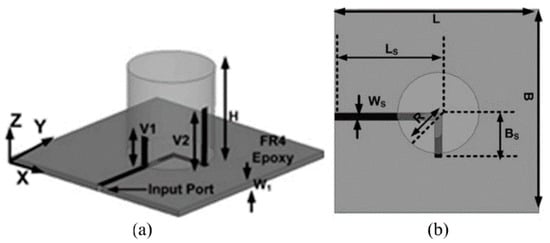
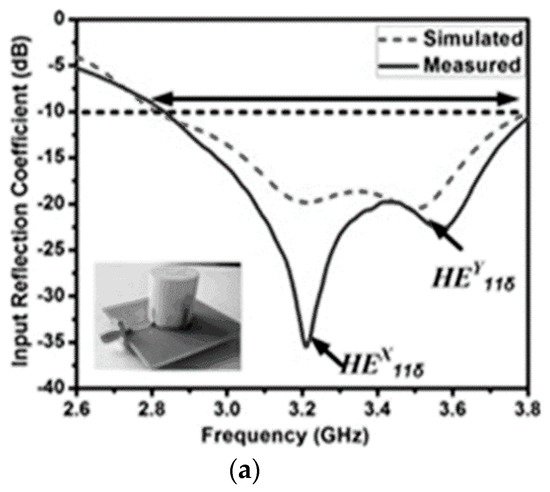
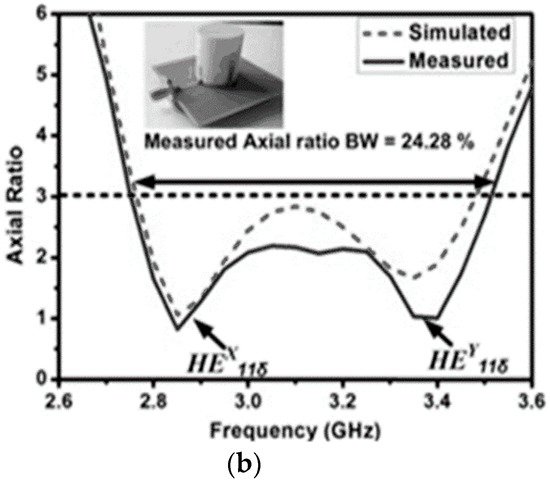
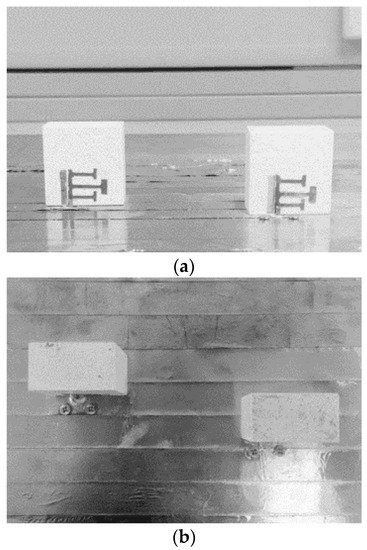
3.2. Multi-Functional Hybrid Antennas with CP Radiation
A combination of ring-shaped microstrip and cylindrical DR elements has been designed for dual functional applications. In this particular configuration, an independently operated microstrip-based annular ring and cylindrical dielectric resonators are used to form a hybrid structure [75], to produce dual CP-radiated bands at 4.2 GHz and 6.4 GHz, respectively, with the return-loss bandwidth higher than 6% at each band. By short-circuiting the annular ring to the ground, the perturbation of radiation patterns can be avoided after assembling both the resonators significantly. However, the shift in the resonant frequency due to the short circuit can be adjusted by modifying the annular ring dimensions. A dual CP hybrid DR antenna is formed [76] by introducing a zonal slot cut on a conducting-cavity, along with a DR element. The lower and upper bands are achieved by zonal slot and DR elements positioned on the side-wall and top of the cavity wall. An L-shaped probe is used to feed the zonal slot antenna in the cavity and an indirect cross-coupling slot is incorporated to feed the DR element. Two even cuts are introduced to achieve CP radiation fields, and another cut is introduced in the zonal slot to obtain the desired AR. Regular unequal lengths of cross-slots under the DR element introduces another perpendicular degenerated mode for CP fields. A cross-slot is used as an aperture feed and as a radiator to produce dual-CP-bands [77].
3.3. Dual-Sense Polarized Hybrid Antennas
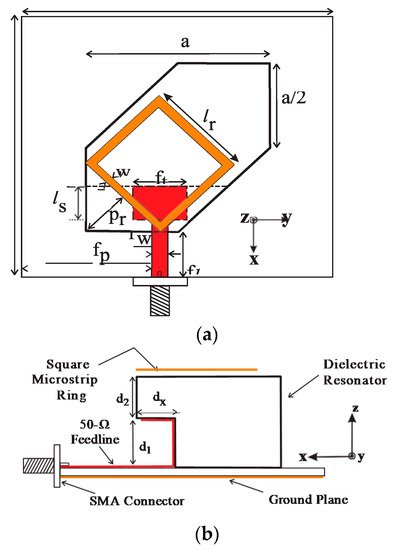
4. Future Scope and Challenges
-
Employing metamaterial concepts and magnetic LC resonators on the metallic patch, considering dielectric-loaded patch and metallic patch loaded on top of dielectric antennas.
-
Various available fractal concepts can be employed on the patch as well as the DR elements particularly to achieve multifunctional bands of resonance.
-
Existing bandwidth and gain enhancement techniques can be applied for the combined form of hybrid DR-based antennas.
-
A combination of a metallic waveguide, microstrip, and DR antennas with a proper feeding mechanism can be developed for future radar applications.
This entry is adapted from the peer-reviewed paper 10.3390/s21124100
References
- Balanis, C.A. Antenna Theory: Analysis and Design; Wiley: New York, NY, USA, 1982.
- Kraus, J. Antennas since Hertz and Marconi. IEEE Trans. Antennas Propag. 1985, 33, 131–137.
- Sethares, J.; Naumann, S. Design of Microwave Dielectric Resonators. IEEE Trans. Microw. Theory Tech. 1966, 14, 2–7.
- Guillon, P.; Garault, Y. Accurate Resonant Frequencies of Dielectric Resonators. IEEE Trans. Microw. Theory Tech. 1977, 25, 916–922.
- Legier, J.F.; Kennis, P.; Toutian, S.; Citeme, J. Resonant Frequencies of Rectangular Dielectric Resonators. IEEE Trans. Microw. Theory Tech. 1980, 28, 1031–1034.
- Singh, D.; Morgan, G. Technical memorandum higher mode resonances of high permittivity square cuboid dielectric resonators on integrated circuit substrates. IEE Proc. H Microw. Antennas Propag. 1987, 134, 563–565.
- Mongia, R.K.; Ittipiboon, A.; Cuhaci, M.; Roscoe, D. Radiation Q-factor of rectangular dielectric resonator antennas: Theory and experiment. In Proceedings of the IEEE Antennas and Propagation Society International Symposium and URSI National Radio Science Meeting, Seattle, WA, USA, 20–24 June 1994; 1994; pp. 764–767.
- Petosa, A.; Simons, N.; Siushansian, R.; Ittipiboon, A.; Cuhaci, M. Design and Analysis of Multi-Segment Dielectric Resonator Antennas. IEEE Trans. Antennas Propag. 2000, 48, 738–742.
- Lee, M.T.; Luk, K.M.; Leung, K.W.; Leung, M.K. A small dielectric resonator antenna. IEEE Trans. Antennas Propag. 2002, 50, 1485–1487.
- Denidni, T.; Rao, Q.; Sebak, A. Multi-eccentric ring slot-fed dielectric resonator antennas for multi-frequency operations. In Proceedings of the IEEE Antennas Propagation Society International Symposium, Monterrey, QC, Canada, 5 June 2004.
- Mongia, R.K.; Bhartia, P. Dielectric Resonator Antennas—A Review and General Design Relations for Resonant Frequency and Bandwidth. Int. J. Microw. Millim. Wave Comput. Aided Eng. 1994, 4, 230–247.
- Rao, Q.; Denidni, T.A. Study of Broadband Dielectric Resonator Antennas. PIERS Online 2005, 1, 137–141.
- Majeed, A.H.; Abdullah, A.S.; Elmegri, F.; Sayidmarie, K.H.; Abd-Alhameed, R.A.; Noras, J.M. Dual-Segment S-shaped Aperture-Coupled Cylindrical Dielectric Resonator Antenna for X-band Applications. IET Microw. Ant. Prop. 2015, 9, 1673–1682.
- Guha, D.; Antar, Y.M.M. Ultra-Wideband Monopole-Dielectric Resonator Antennas: Designs and Advances. In Proceedings of the 2010 URSI International Symposium on Electromagnetic Theory, Berlin, Germany, 16–19 August 2010; IEEE: New York, NY, USA; pp. 428–431.
- Petosa, A.; Ittipiboon, A. Dielectric Resonator Antennas: A Historical Review and the Current State of the Art. IEEE Antennas Propag. Mag. 2010, 52, 91–116.
- Leung, K.W.; Lim, E.H.; Fang, X.S. Dielectric Resonator Antennas: From the Basic to the Aesthetic. Proc. IEEE 2012, 100, 2181–2193.
- Soren, D.; Ghatak, R.; Mishra, R.K.; Poddar, D.R. Dielectric Resonator Antennas: Designs and Advances. Prog. Electromagn. Res. B 2014, 60, 195–213.
- Kumari, R.; Gangwar, R.K. Circularly Polarized Dielectric Resonator Antennas: Design and Developments. Wirel. Pers. Commun. 2015, 86, 851–886.
- Dash, S.K.K.; Khan, T.; De, A. Modelling of dielectric resonator antennas using numerical methods: A review. J. Microw. Power Electromagn. Energy 2016, 50, 269–293.
- Dash, S.K.K.; Khan, T.; De, A. Dielectric resonator antennas: An application oriented survey. Int. J. RF Microw. Comput. Eng. 2016, 27, e21069.
- Ullah, U.; Ain, M.F.; Ahmad, Z.A. A review of wideband circularly polarized dielectric resonator antennas. China Commun. 2017, 14, 65–79.
- Dash, S.K.K.; Khan, T. Recent developments in bandwidth improvement of dielectric resonator antennas. Int. J. RF Microw. Comput. Eng. 2019, 29, e21701.
- Banerjee, U.; Karmakar, A.; Saha, A. A review on circularly polarized antennas, trends and advances. Int. J. Microw. Wirel. Technol. 2020, 12, 922–943.
- George, J.; Aanandan, C.K.; Mohanan, P.; Nair, K.G.; Sreemoolanadhan, H.; Sebastian, M.T. Dielectric Resonator Loaded Microstrip Antenna for Enhanced Impedance Bandwidth and Efficiency. Microw. Opt. Technol. Lett. 1993, 17, 205–207.
- Lda, I.; Sato, J.; Yoshimura, H.; Lto, K. Improvement in the Efficiency-Bandwidth Product in Small Dielectric-Loaded Antennas. Electron. Lett. 2000, 36, 861–862.
- Bijumon, P.V.; Menon, S.K.; Sebastian, M.T.; Mohanan, P. Enhanced bandwidth microstrip patch antennas loaded with high permittivity dielectric resonators. Microw. Opt. Technol. Lett. 2002, 35, 327–330.
- Gupta, V.; Sinha, S.; Koul, S.K.; Bhat, B. Wideband dielectric resonator-loaded suspended microstrip patch antennas. Microw. Opt. Technol. Lett. 2003, 37, 300–302.
- Lapierre, M.; Antar, Y.; Ittipiboon, A.; Petosa, A. A wideband monopole antenna using dielectric resonator loading. In Proceedings of the IEEE Antennas and Propagation Society International Symposium. Digest. Held in Conjunction with: USNC/CNC/URSI North American Radio Sci. Meeting (Cat. No.03CH37450), Columbus, OH, USA, 22–27 June 2003; pp. 16–19.
- Fan, Z.; Antar, Y.; Ittipiboon, A.; Petosa, A. Parasitic coplanar three-element dielectric resonator antenna subarray. Electron. Lett. 1996, 32, 789.
- Esselle, K.P. A Dielectric-Resonator-On-Patch (DROP) Antenna for Broadband Wireless Applications: Concept and Re-sults. In Proceedings of the IEEE Antennas and Propagation Society International Symposium, Boston, MA, USA, 8–13 July 2001; pp. 22–25.
- Esselle, K.P.; Bird, T.S. Hybrid Resonator Antennas for Broadband Wireless Applications. In Proceedings of the XXVllth General Assembly of the International Union of Radio Science (URSI), Maastricht, The Netherlands, 17–24 August 2002.
- Leung, K.W.; Wong, W.; Ng, H. Circularly polarized slot-coupled dielectric resonator antenna with a parasitic patch. IEEE Antennas Wirel. Propag. Lett. 2002, 1, 57–59.
- Gao, Y.; Ooi, B.-L.; Ewe, W.-B.; Popov, A.P. A compact wideband hybrid dielectric resonator antenna. IEEE Microw. Wirel. Components Lett. 2006, 16, 227–229.
- Nasimuddin, N.; Esselle, K. A Low-Profile Compact Microwave Antenna with High Gain and Wide Bandwidth. IEEE Trans. Antennas Propag. 2007, 55, 1880–1883.
- Coulibaly, Y.; Denidni, T.A.; Boutayeb, H. Broadband Microstrip-Fed Dielectric Resonator Antenna for X-Band Applications. IEEE Antennas Wirel. Propag. Lett. 2008, 7, 341–345.
- Jazi, M.N.; Denidni, T.A. Design and Implementation of an Ultrawideband Hybrid Skirt Monopole Dielectric Resonator Antenna. IEEE Antennas Wirel. Propag. Lett. 2008, 7, 493–496.
- Ahmed, O.M.H.; Sebak, A.R.; Denidni, T.A. Size Reduction and Bandwidth Enhancement of a UWB Hybrid Dielectric Resonator Antenna for Short-Range Wireless Communications. Prog. Electromagn. Res. Lett. 2010, 19, 19–30.
- Ozzaim, C. Monopole Antenna Loaded by a Stepped-Radius Dielectric Ring Resonator for Ultrawide Bandwidth. IEEE Antennas Wirel. Propag. Lett. 2011, 10, 843–845.
- Denidni, T.; Weng, Z. Hybrid ultrawideband dielectric resonator antenna and band-notched designs. IET Microw. Antennas Propag. 2011, 5, 450.
- Guha, D.; Gupta, B.; Antar, Y.M.M. Hybrid Monopole-DRAs Using Hemispherical/Conical-Shaped Dielectric Ring Resonators: Improved Ultra-wideband Designs. IEEE Trans. Antennas Propag. 2012, 60, 393–398.
- Ozzaim, C.; Ustuner, F.; Tarim, N. Stacked Conical Ring Dielectric Resonator Antenna Excited by a Monopole for Improved Ultrawide Bandwidth. IEEE Trans. Antennas Propag. 2012, 61, 1435–1438.
- Wang, Y.; Liu, S.; Denidni, T.A.; Zeng, Q.; Wei, G. Integrated Ultra-Wideband Planar Monopole with Cylindrical Dielectric Resonator Antennas. Prog. Electromagn. Res. C 2013, 44, 41–53.
- Wang, Y.; Denidni, T.; Zeng, Q.; Wei, G. Design of high gain, broadband cylindrical dielectric resonator antenna. Electron. Lett. 2013, 49, 1506–1507.
- Chaudhary, R.K.; Kumar, R.; Srivastava, K.V. Wideband Ring Dielectric Resonator Antenna with Annular-Shaped Microstrip Feed. IEEE Antennas Wirel. Propag. Lett. 2013, 12, 595–598.
- Zou, M.; Pan, J. Investigation of Resonant Modes in Wideband Hybrid Omnidirectional Rectangular Dielectric Resonator Antenna. IEEE Trans. Antennas Propag. 2015, 63, 3272–3275.
- Xing, L.; Huang, Y.; Xu, Q.; Alja’Afreh, S. A Wideband Hybrid Water Antenna with an F-Shaped Monopole. IEEE Access 2015, 3, 1179–1187.
- Xing, L.; Huang, Y.; Xu, Q.; Alja’Afreh, S. Wideband, hybrid rectangular water antenna for DVB-H applications. Microw. Opt. Technol. Lett. 2015, 57, 2160–2164.
- Erfani, E.; Niroo-Jazi, M.; Tatu, S.; Denidni, T. A Hybrid Dielectric Resonator Antenna for Spectrum Sensing and Ultra-Wideband Applications. Microw. Opt. Tech. Lett. 2016, 58, 2609–2611.
- Qian, Y.-H.; Chu, Q.-X. A Broadband Hybrid Monopole-Dielectric Resonator Water Antenna. IEEE Antennas Wirel. Propag. Lett. 2017, 16, 360–363.
- Agrawal, S.; Parihar, M.S.; Kondekar, P.N. Performance Analysis of a Low-Profile Hybrid Antenna for Broadband Applications. Wirel. Pers. Commun. 2018, 100, 995–1007.
- Song, Z.; Zheng, H.; Wang, M.; Li, Y.; Song, T.; Li, E.; Li, Y. Equilateral Triangular Dielectric Resonator and Metal Patch Hybrid Antenna for UWB Application. IEEE Access 2019, 7, 119060–119068.
- Gao, Y.; Ooi, B.-L.; Popov, A.P. Dual-band hybrid dielectric resonator antenna with CPW-fed slot. Microw. Opt. Technol. Lett. 2005, 48, 170–172.
- Qinjiang, R.; Tayeb, A.D.; Sebak, A.R. A Hybrid Resonator Antenna Suitable for Wireless Communication Applications at 1.9 and 2.45 GHz. IEEE Antennas Wirel. Propag. Lett. 2005, 4, 341–343.
- Rao, Q.; Denidni, T.; Johnston, R. A novel feed for a multifrequency hybrid resonator antenna. IEEE Microw. Wirel. Components Lett. 2005, 15, 238–240.
- Ding, Y.; Leung, K.W. On the Dual-Band DRA-Slot Hybrid Antenna. IEEE Trans. Antennas Propag. 2009, 57, 624–630.
- Iellici, D.; Kingsley, S.P.; Kingsley, J.W.; O’Keefe, S.G.; Tyler, S.W.S. Hybrid Antenna Using Parasitic Excitation of Conducting Antennas by Dielectric Antennas. U.S. Patent 7,545,327, 9 June 2009.
- Yeom, J.; Jeon, S.; Choi, H.; Kim, H. Compact Hybrid DRA Combined with PIFA. IEICE Trans. Commun. 2010, E93-B, 2781–2783.
- Mitra, S.B.; Gupta, B. A novel multifrequency hybrid antenna. Microw. Opt. Technol. Lett. 2013, 55, 2712–2715.
- Messaoudene, I.; Denidni, T.A.; Benghalia, A. A Hybrid Integrated Ultra-Wideband/Dual-Band Antenna with High Isolation. Int. J. Microw. Wirel. Tech. 2015, 8, 341–346.
- Dhar, S.; Patra, K.; Ghatak, R.; Gupta, B.; Poddar, D.R. A Dielectric Resonator-Loaded Minkowski Fractal-Shaped Slot Loop Hepta-Band Antenna. IEEE Trans. Antennas Propag. 2015, 63, 1521–1529.
- Sahu, N.K.; Sharma, A.; Gangwar, R.K. Modified annular ring patch fed cylindrical dielectric resonator antenna for WLAN/WIMAX applications. Microw. Opt. Technol. Lett. 2017, 59, 120–125.
- Sharma, A.; Das, G.; Gangwar, R.K. Dual-band circularly polarized hybrid antenna for WLAN/WiMAX applications. Microw. Opt. Technol. Lett. 2017, 59, 2450–2457.
- Das, G.; Sharma, A.; Gangwar, R.K. Triple-Band Hybrid Antenna with Integral Isolation Mechanism for MIMO Applications. Microw. Opt. Tech. Lett. 2018, 60, 1482–1491.
- Das, G.; Sharma, A.; Gangwar, R.K. Dielectric resonator-based two-element MIMO antenna system with dual band characteristics. IET Microw. Antennas Propag. 2018, 12, 734–741.
- Anshul, G.; Ravi, K.G. Hybrid Rectangular Dielectric Resonator Antenna for Multiband Applications. IETE Tech. Rev. 2019, 37, 83–90.
- Lin, I.K.C.; Jamaluddin, M.H.; Awang, A.; Selvaraju, R.; Dahri, M.H.; Yen, L.C.; Rahim, H.A. A Triple Band Hybrid MIMO Rectangular Dielectric Resonator Antenna for LTE Applications. IEEE Access 2019, 7, 122900–122913.
- Antar, Y.M.M.; Guha, D. Composite and Hybrid Dielectric Resonator Antennas: Recent Advances and Challenges. In Proceedings of the Twenty Third National Radio Science Conference (NRSC’2006), Menouf, Egypt, 14–16 March 2006; pp. 1–7.
- Stout, S.M. Compact Dielectric-Loaded Patch Antennas for L-Band Mobile Satellite Applications. Master’s Thesis, Carleton University, Ottawa, ON, Canada, September 1999.
- Currie, C.J.; Antar, Y.M.; Petosa, A.; Ittipiboon, A. Compact Circularly Polarized Antenna Designs using Dielectrics. In Proceedings of the URSI Conference, Victoria, BC, Canada, 13–17 May 2001; pp. 359–361.
- Currie, C.J.; Antar, Y.M.M.; Petosa, A.; Ittipiboon, A. Compact Dielectric Loaded Circularly Polarized Microstrip Antenna. Electron. Lett. 2001, 37, 1104–1105.
- Zou, M.; Pan, J. Wideband Hybrid Circularly Polarized Rectangular Dielectric Resonator Antenna Excited by Modified Cross-Slot. Electron. Lett. 2014, 50, 1123–1125.
- Lu, L.; Jiao, Y.-C.; Zhang, H.; Wang, R.; Li, T. Wideband Circularly Polarized Antenna with Stair-Shaped Dielectric Resonator and Open-Ended Slot Ground. IEEE Antennas Wirel. Propag. Lett. 2016, 15, 1755–1758.
- Chowdhury, R.; Mishra, N.; Sani, M.M.; Chaudhary, R.K. Analysis of a Wideband Circularly Polarized Cylindrical Dielectric Resonator Antenna with Broadside Radiation Coupled with Simple Microstrip Feeding. IEEE Access 2017, 5, 19478–19485.
- Iqbal, J.; Illahi, U.; Sulaiman, M.I.; Alam, M.M.; Su’ud, M.M.; Mohd Yasin, M.N. Mutual Coupling Reduction using Hybrid Technique in Wideband Circularly Polarized MIMO Antenna for WiMAX Applications. IEEE Access 2019, 7, 40951–40958.
- Nannini, C.; Ribero, J.-M.; Dauvignac, J.-Y.; Pichot, C. A Dual-Frequency Circularly Polarized Structure Antenna. Microw. Opt. Technol. Lett. 2002, 32, 418–420.
- Ding, Y.; Leung, K.W.; Luk, K.M. Compact Circularly Polarized Dual-band Zonal-Slot/DRA Hybrid Antenna Without External Ground Plane. IEEE Trans. Antennas Propag. 2011, 59, 2404–2409.
- Zou, M.; Pan, J.; Zuo, L.; Nie, Z.-P. Investigation of a cross-slot-coupled dual-band circularly polarized hybrid dielectric resonator antenna. Prog. Electromagn. Res. C 2014, 53, 187–195.
- Guha, D.; Antar, Y.M.M.; Ittipiboon, A.; Petosa, A.; Lee, D. Improved design guidelines for the ultra wideband monopole-dielectric resonator antenna. IEEE Antennas Wirel. Propag. Lett. 2006, 5, 373–376.
- Lapierre, M.; Antar, Y.; Ittipiboon, A.; Petosa, A. Ultra wideband monopole/dielectric resonator antenna. IEEE Microw. Wirel. Components Lett. 2005, 15, 7–9.
- Gray, D.; Watanabe, T. Three Orthogonal Polarization DRA-Monopole Ensemble. Electron. Lett. 2003, 39, 766–767.
- Sharma, A.; Gangwar, R.K. Triple-band dual-polarized hybrid cylindrical dielectric resonator antenna with hybrid modes excitation. Prog. Electromagn. Res. C 2016, 67, 97–105.
- Sahu, N.K.; Sharma, A.; Gangwar, R.K. Design and analysis of wideband composite antenna with dual-sense circular polarization characteristics. Microw. Opt. Technol. Lett. 2018, 60, 2048–2054.
- Altaf, A.; Seo, M. Triple-Band Dual-Sense Circularly Polarized Hybrid Dielectric Resonator Antenna. Sensors 2018, 18, 3899.
- Kumar, R.; Nasimuddin; Chaudhary, R.K. Wideband circularly polarized hybrid dielectric resonator antenna with bi-directional radiation characteristics for various wireless applications. Int. J. RF Microw. Comput. Eng. 2019, 29.
- Darimireddy, N.K.; Park, C.-W.; Reddy, R.R.; Reddy, B.R.S. Multi-Band Rectangular Hybrid Antennas Loaded with Inter-Digital Structure Slot. In Proceedings of the IEEE Indian Conference on Antennas and Propagation (IEEE-InCAP), Ahmedabad, India, 19–22 December 2019.
